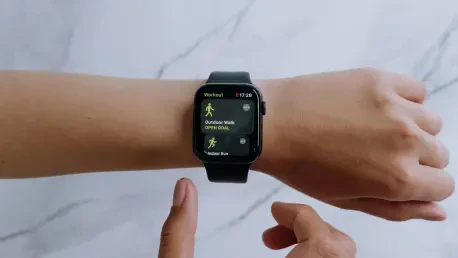In the ever-evolving landscape of wearable technology, Apple stands as a titan, transforming devices like the Apple Watch from simple fitness trackers into sophisticated health monitoring tools that have captured the imagination of millions. Yet, this journey of innovation is far from smooth, as the company finds itself entangled in high-stakes legal disputes that challenge its market dominance and strategic direction. A notable clash with Masimo over blood oxygen monitoring technology has thrust Apple into the spotlight, raising questions about how patent battles influence technological advancement. Beyond the courtroom, regulatory scrutiny and consumer expectations add layers of complexity to Apple’s path forward. This article delves into the intricate dance between legal challenges, cutting-edge innovation, and market dynamics, exploring how Apple navigates these obstacles to redefine the future of wearable health tech while maintaining its competitive edge in a rapidly growing industry.
Legal Hurdles and Strategic Adaptations
Apple’s ongoing patent dispute with Masimo over blood oxygen monitoring technology has become a defining moment in its wearable tech saga. Back in 2023, the U.S. International Trade Commission determined that Apple infringed on Masimo’s pulse oximetry patents, leading to a temporary import ban on certain Apple Watch models and the disabling of the feature in the U.S. market. Rather than succumbing to the pressure of expensive licensing agreements, Apple demonstrated remarkable agility by engineering a workaround. By shifting the calculations for the blood oxygen feature to the paired iPhone, the company managed to preserve the user experience without directly violating the ruling. This strategic pivot not only sidestepped a significant financial burden but also underscored Apple’s ability to adapt under legal constraints, turning a potential setback into a testament to its problem-solving prowess in the face of intellectual property challenges.
The broader implications of this legal battle extend beyond a single feature or device, shedding light on the dual nature of patent litigation in the tech industry. Such disputes often act as both barriers and catalysts, pushing companies like Apple to innovate while simultaneously posing risks to smaller players reliant on patent enforcement. For Masimo, the financial volatility following the dispute has been evident, with stock value fluctuations highlighting the high stakes involved. Apple’s response, however, reflects a calculated approach to maintaining market position without compromising on core functionality. This case serves as a microcosm of the wearable tech sector’s legal landscape, where intellectual property conflicts can reshape competitive dynamics and force companies to rethink their strategies. As Apple continues to navigate these waters, its ability to balance legal obligations with consumer expectations remains a critical factor in sustaining its leadership.
Pushing Boundaries with AI and Technology
Apple’s commitment to innovation shines through its response to legal challenges, particularly with the reintroduction of the blood oxygen feature via software updates like iOS 18.6.1 and watchOS 11.6.1. This technical workaround is a clear demonstration of the company’s robust research and development capabilities, ensuring that users retain access to vital health tools despite external pressures. Beyond this immediate fix, Apple is investing heavily in artificial intelligence to elevate the Apple Watch’s role in personal health management. The Wearable Behavior Model, built on an extensive dataset of 2.5 billion hours from thousands of users, represents a groundbreaking shift. With a reported 92% accuracy in predicting conditions such as atrial fibrillation, this AI-driven approach moves beyond traditional sensor data, focusing instead on behavioral patterns to offer deeper health insights.
This technological leap positions the Apple Watch as more than a passive device; it transforms into a proactive health companion tailored to individual needs. The integration of AI not only aligns with rising consumer demand for personalized solutions but also sets a new standard for what wearables can achieve in preventive care. Unlike conventional health tracking that relies heavily on physical metrics, Apple’s emphasis on behavioral analysis opens up possibilities for early detection of serious conditions, potentially revolutionizing user engagement with health tech. However, this ambitious direction is not without its challenges, as the accuracy and reliability of such predictions must be continually validated to maintain trust. Apple’s forward-thinking strategy in leveraging AI underscores its intent to lead the wearable tech market into a future where devices anticipate health needs before they become critical issues.
Regulatory Challenges in Health Tech Evolution
As Apple pushes the envelope with advanced health features, it must also navigate an increasingly complex regulatory landscape that shapes the wearable tech industry. The U.S. Food and Drug Administration has intensified its scrutiny of devices under the Software as a Medical Device framework, imposing stringent requirements for validation studies to ensure safety and accuracy. These regulations, while essential for protecting consumers, can significantly increase research and development costs and delay the rollout of innovative features. For a company like Apple, which thrives on rapid iteration, such hurdles pose a tangible risk to maintaining its competitive pace. The potential for prolonged approval processes could hinder the timely introduction of AI-driven health tools, even as the company strives to meet evolving standards.
On a global scale, frameworks like the EU’s AI Act add another layer of compliance demands that Apple must address to maintain its international presence. The company’s focus on on-device AI processing and privacy-first designs, exemplified by initiatives like Private Cloud Compute, may help ease the path to regulatory approval by prioritizing data security. Nevertheless, the uncertainty surrounding approval timelines remains a persistent concern, as delays could disrupt Apple’s innovation cycle and affect market perception. Balancing the drive for cutting-edge health solutions with the need to adhere to diverse regulatory requirements is a delicate task. Apple’s ability to adapt its technologies to align with these standards will be crucial in ensuring that its wearable devices continue to lead the industry without falling afoul of legal or ethical boundaries.
Market Growth and Consumer Confidence
The wearable health tech market is on a remarkable growth trajectory, with projections estimating an 18% compound annual growth rate through 2030, fueled by aging demographics and a rising demand for remote monitoring solutions. Apple, as a dominant player, stands to benefit significantly from these trends, provided it can sustain consumer confidence amid various challenges. Legal disputes, while often behind the scenes, can indirectly influence public perception if they result in feature limitations or product unavailability. Apple’s adept handling of the blood oxygen feature issue has helped mitigate such risks, maintaining a seamless user experience that reinforces brand loyalty. However, the industry as a whole faces broader concerns about the reliability of health data, which can erode trust if not addressed proactively.
Consumer skepticism, often fueled by past inaccuracies in health readings across wearable devices, represents a significant hurdle for Apple and its competitors. Instances of misleading data have even led to class-action lawsuits in the sector, highlighting the importance of precision in health tech. Apple’s challenge lies in continuously improving the accuracy of its devices while transparently communicating limitations to users. Beyond technical reliability, fostering trust also involves ensuring that privacy remains a cornerstone of its offerings, especially as health data becomes increasingly sensitive. As the market expands, Apple’s ability to balance growth opportunities with the imperative of maintaining consumer faith will play a pivotal role in shaping its long-term success in the wearable tech arena.
Investment Perspectives in a Dynamic Sector
From an investor’s standpoint, Apple’s journey through legal, technological, and regulatory challenges offers a compelling case study in the wearable health tech sector. The company’s strategic navigation of patent disputes, coupled with its forward-looking investment in AI-driven health solutions, positions it as a robust contender in a market brimming with potential. However, the risks are equally significant, as intellectual property conflicts can drain resources and regulatory delays may stall innovation. Investors must weigh Apple’s proven resilience against these uncertainties, recognizing that while the company’s deep expertise and ecosystem strength provide a competitive advantage, no player is immune to industry-wide disruptions that could impact growth.
Diversification emerges as a prudent strategy for those looking to capitalize on the wearable tech boom while mitigating risks. Monitoring evolving FDA policies on Software as a Medical Device classifications will be essential, as these regulations could shape the pace of innovation across the sector. Additionally, considering investments in smaller innovators focusing on niche areas like sensor technology and AI diagnostics can provide a buffer against potential setbacks faced by larger entities like Apple. The wearable health tech market, with its promise of substantial returns, demands a nuanced approach to risk management. Apple’s trajectory suggests long-term value, but a balanced portfolio that accounts for the sector’s volatility remains a wise choice for navigating this dynamic landscape.
Shaping the Path Forward for Wearable Tech
Reflecting on Apple’s multifaceted role in wearable tech, it’s evident that the company has charted a bold course by integrating AI and behavioral data analysis to transform devices into essential health tools. The adept handling of legal disputes with innovative workarounds has showcased a resilience that keeps Apple at the forefront of the industry. Yet, the regulatory tightrope it walks underscores a broader tension between innovation and compliance that defines the sector’s past challenges. Looking ahead, the focus should shift to forging partnerships with regulatory bodies to streamline approval processes, ensuring that groundbreaking features reach consumers without undue delay. Simultaneously, Apple and its peers must prioritize transparency in health data accuracy to rebuild and sustain consumer trust. For stakeholders, the next steps involve closely tracking policy shifts and investing in collaborative solutions that address ethical concerns, paving the way for a future where wearable tech seamlessly integrates into preventive healthcare.









